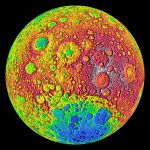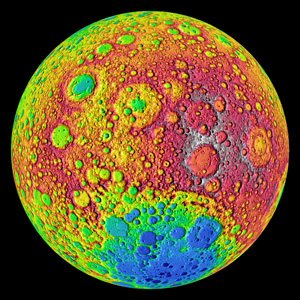The DiPietro Hypothesis: How the Moon Formed and From What.

By Tanner2
Authors DT Smith, SB DiPietro
The Moon is not from the remnants of a collision by a planet named “Theia” that hit the Earth! The Giant Impact Theory is completely wrong!
The image above shows the “mud” craters on the farside of the Moon. All scientist think these are impact craters and they are not. At the bottom of the image is the South Pole Aitken Basin, which all scientist think is the “largest impact crater in our Solar System”. It is not, it is the Bellybutton scar from the Umbilical that was attached from the Earth to the Sun.
The Moon is from the Umbilical that was attached from the Sun to the Earth. See video https://youtu.be/2r-zaWF6S_M. The Umbilical was molten plasma stardust, star waste and slush made from the components of Earth’s molten lithosphere. The Moons surface is consistent due to the fact the Moon is from portions of the Earth’s lithosphere. The components of the lithosphere that were the lightest of the stardust, star slag, star waste and water ice that floated on the surface of the Sun. The Earth was force “dripped” through this surface slurry mixture from the Equator bulge of the Sun. Physics will prove this correct when adequate models in real life and in computer models will show how a forced drip from under a layered concoction of soup from star slag to stardust with water ice, will prove where the Moon came from and how our complete Solar System formed.
The Moon is simply not from a collision!
For millions of years the Moon cooled down from this molten plasma sphere. On the nearside of the Moon the gravity of the Earth pulled up the components of the Maria, from inside this molten sphere. These minerals “puddled” on the surface of the Moon creating the “ocean” or “sea” we call Mare. These Maria, are what tricked scientist to think there were volcanoes that created magma oceans that covered the Moon, which it was not and completely wrong! Scientist made a wrong assumption about the Moon’s makeup and forming.
On the farside of the Moon, thousands of craters, which are not impact craters, but are “mud” craters made from stardust, star waste and water ice mixed throughout this molten plasma sphere of the Moon. The farside “mud” craters boiled to the surface with the help of the Sun’s gravity, creating numerous “mud” craters on the farside. As the steam rose to the surface creating these large regolith “mud” craters. We don’t believe there are any obvious impact craters on the farside.
While the steam rose, the heavier metals like nickel and iron accreted towards the core, creating the Moon’s metal core. The Sun’s gravity on the farside created 90% of the “mud” craters by pulling water steam to the surface. All this crater activity, on the farside caused by the Sun’s gravity increased the thickness of the Moon’s crust. This was all happening from the Moon cooling down from being a completely molten sphere. Impact craters on the farside of the Moon seem nonexistence and not obvious. This has also ticked scientist to think all craters on both sides are impact craters and they are wrong. How they were tricked is that a collapsed and frozen mud crater is similar looking to an impact crater, but are different. An impact crater leaves scares and streaks.
The iron and nickel in this molten plasma sphere accreted to the core along with any other heavy metals, creating the metal core of the Moon we know today. While the water and lighter elements flowed to the surface, assisted by the molten heat cooling down and the steam of the water being pushed to the surface through this plasma sphere along with the pull of the Sun on the farside and the Earth’s gravity on the nearside.
The Ferroan Anorthosite that is found on the Moon’s surface is 4.4 billion years old. The same Anorthosite on Earth is in large areas located in the continental shelf and the lithosphere. The Anorthosite on the Moon went through a 4.5 billion years of transformation. The Anorthosite that is found in the lithosphere of Earth is basically the same as Ferroan Anorthosite on the Moon, except the Moon’s Anorthosite went through a different “tempering” process. The Moon’s Anorthosite which scientist call Ferroan Anorthosite has been exposed to a heating, cooling and atmospheric process on the Moon for a long time, for millions of years until now. Where the Anorthosite on Earth settled into the lithosphere on Earth and did not transform like its cousins from the Moon.
Anorthosite: A pale gray rock that forms when lighter materials float to the top of cooling molten rock.
The Moon was never covered in an ocean of magma and lava. The Lunar Magma Ocean Model is wrong. The complete Moon was a molten sphere of stardust, star waste, star slag and ice water. The “magma” on the Moon is from the “Crust of the Sun” Emanuel Swedenborg 1734 and was imbedded and mixed in this molten sphere. The large deposits of anorthosite on Earth is from the “crust of the Sun”, the star waste.
Read the DiPietro Hypothesis. This Anorthosite which is basaltic rock that mixed and bonded with magnesium and titanium then surfaced in the Maria “seas” of the Moon. Tricking all scientist to think that the Maria are magma and lava filled basins on the Moon. There were no volcanoes of any kind on the Moon. Only a completely molten sphere that had to cool down after forming from the molten Umbilical of the Earth which was made from the “crust of the Sun”.
The magnesium and titanium bonded together with basalt and created the Maria(seas) of the Moon. As this molten sphere made-up of Earth’s lithosphere started to cool the magnesium and titanium along with the molten basalt bonded, they came to the surface from the heat, steam and water, helped by the gravity of the Earth. The Earth’s gravity was the biggest force on the nearside of the Moon. The Earth’s gravity is what pulled the components of the “seas” to the surface where they “puddled”.
The Moon was a droplet of Molten Stardust Plasma, it was never an ocean of magma. The Lunar Magma Ocean Model is wrong. It was more than an ocean of magma; the complete Moon was a molten plasma sphere made from star waste, star slag, stardust and crushed ice, when it transformed from the Umbilical of Earth.
One reason the lunar nearside crust appears to be much thinner than the farside, is the Moon was a molten sphere from the Umbilical, this is a 2,162-mile diameter and 8.1 x 10²⁰ tons of molten plasma, mainly from Earth’s lithosphere. Did you see the contortions that molten plasma went through to become a round sphere? See video https://youtu.be/2r-zaWF6S_M. We will let the scientist figure that out. Plus, the Sun pulled on the farside while the Earth pulled on the nearside affecting the crust of the Moon on both sides.
Real impact craters on the Moon are obvious and show the evidence of impact. 90% of the craters on the Moon are “mud” craters.
All four terrestrial planets Mercury, Venus, Earth, Mars and the Moon, had water-ice mixed with each one’s composition as molten plasma spheres and some with Surface Slag and some without. Earth and Venus received the most Surface Slag while Mercury and Mars missed out on Surface Slag. All four planets had water ice in their molten state.
Most of the craters on Mercury, Mars and the Moon are “Stardust Mud Craters” which is from the water, as water ice, escaped from the interior to the surface of each of those planets and the Moon. You don’t see “mud” craters on Earth, Earth always had water and never lost its surface water. Plus, “mud” craters did not surface through the Earth’s Continental Shelf, maybe in low lying areas on Continental Shelf, and if they did elsewhere the surface water dissolved them. Our Continental Shelf is Surface Slag from the Sun, which floated on the surface of our molten sphere, the Earth, we call that Surface Slag ProtoGaia.
The Moon is not the results of a collision! You can computer model a planet’s collision with Earth to you are Blue in the Face and it will not prove anything of how the Moon formed. A collision does not make sense in any practical way.
Model the Moon forming from the Umbilical of Earth that “dripped” through the surface slag at the equator bulge and into the gravity disk of the Sun followed by the Moon forming from the Umbilical that was attached to the Sun. All you brand new scientist model that.
The Moon is from the Umbilical of the Earth to the Sun. This molten droplet of plasma was loaded down with stardust, star waste, star slag and ice slurry.
See video How the Earth and Moon Formed https://youtu.be/2r-zaWF6S_M and also, see video What the Moon is Made Of? https://youtu.be/CuvNCKxAMqE. See video A New Beginning In Planetary Science https://youtu.be/jbHgP-b14Uk, to see ProtoGaia, Earth’s first landmass.
The Lunar Magna Ocean Model is completely wrong. There were no volcanoes on the Moon. The Moon did not happen from a collision. Most of the craters on the Moon are “mud” carters. There are no obvious impact craters on the farside of the Moon.
Authors D.T. Smith and S.B. DiPietro
The DiPietro Hypothesis
How the Moon Formed and From What!
Copyright 2024

